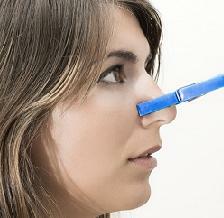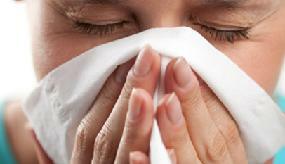 Vasomotor rhinitis is a violation of breathing through the nose due to the narrowing of the nasal cavity, due to the violation of the vascular tone in the mucous membrane. Allergic and neurovegetative form of vasomotor rhinitis is distinguished.
Vasomotor rhinitis is a violation of breathing through the nose due to the narrowing of the nasal cavity, due to the violation of the vascular tone in the mucous membrane. Allergic and neurovegetative form of vasomotor rhinitis is distinguished.
With this disease, the function of the vessels of the nasopharynx is disturbed, and instead of absorbing the mucus, they secrete an excessive amount. In other words, the patient has a persistent runny nose.
At the same time, the nasal passages do not perform an important function - purification of incoming air from harmful substances( dust, microbes and allergens).The difficulty is also in the fact that the nasal canals narrow and light air enters the lungs, which complicates the situation.
Most people decide to eliminate vasomotor rhinitis on their own, without the help of a doctor. To do this, they buy drops in the nose and think that the problem is solved. The view that rhinitis is a trivial illness is erroneous, since inaction will not only exacerbate the disease, but will also cause serious complications. Even the manifestation of a vasomotor runny nose in a mild form can adversely affect the habitual life.
Neurovegetative form of
As a rule, this form of vasomotor rhinitis is not characterized by seasonality. Vasomotor rhinitis is common in all seasons and depends mainly on external provoking factors( dustiness of rooms, aggressive vapors in the inspired air, presence of contact curvatures of the septum of the nose), or from the previously mentioned common neurovegetative dysfunction.
Usually in the latter case, patients are patients not only of a rhinologist, but also a neurologist.
Vasomotor allergic rhinitis
Allergic vasomotor rhinitis occurs when contact with the nasal mucosa with various exogenous allergens. For the seasonal form of allergic vasomotor rhinitis, the presence of exacerbations during the flowering period of certain plant species is characteristic.
Periods of exacerbation in the year-round form are observed irrespective of the season and flowering period, they are caused by an allergen, contact with which is possible throughout the year.
Typical manifestations of allergic vasomotor rhinitis are: the appearance of a sudden abundant mucous compartment, itching and burning, feelings of congestion and headache. Also, redness of eye conjunctiva, edema of eyelids can be observed. Quite often, the Eustachian tubes that connect the nasal cavity with the ear can be involved in the inflammatory process, resulting in a feeling of stuffiness of the ears, the appearance of noise in the ears and hearing loss.
Causes of
Why does vasomotor rhinitis occur, and what is it? The basis of the disease is the differentiation of excitability of the central parts of the autonomic nervous system and peripheral parts, which is why the reaction to the usual physiological stimuli of the nasal mucosa.
The response is manifested by the hyperactivity of the vascular and neurovegetative nasal mucosa, which is manifested by the ability of the mucosa to respond to the effects of various nonspecific and specific stimuli in the form of a papillo-secretory reaction, which is not found in healthy individuals.
Among the most common causes, , the causative vasomotor rhinitis , isolates:
- An allergic reaction that manifests itself in connection with a hormonal disruption, for example, during pregnancy, taking oral contraceptives, hormone treatment and others;
- Abuse of vasoconstrictor drops;
- Sensitivity of the body to a sudden change in temperature( meteosensitivity);
- Stressful situations;
- Allergic rhinitis;
- Vegeto-vascular dystonia.
To , the risk factors for are:
- Harmful habits. It is enough to look at the photo of the internal organs of a smoker to understand all the harm from smoking and alcohol;
- Dry air;
- Separate odors( for example, perfume or tobacco);
- Asthma;
- Gastroesophageal reflux disease;
- Contaminated air;
- Nose damage;
- Spicy food;
- Stressful situations, strong emotional experiences.
Other causes can provoke the disease in adults, it is very important to diagnose the vasomotor form of rhinitis in time and to start complex treatment of the disease in time.

Symptoms of vasomotor rhinitis
In the case of vasomotor rhinitis in adults, nasal breathing is the leading symptom. This leads to a deterioration in ventilation in the lungs, followed by improper circulation in the brain and cardiovascular system. In this regard, there are various disorders of the nervous system:
- sleep disturbance;
- headaches;
- increased fatigue;
- weakness;
- lack of appetite;
- memory degradation.
Also for the vasomotor rhinitis in adults, other symptoms are also characteristic:
- alternating obstruction of one of the nostrils, - this symptom is very indicative;
- the appearance of a feeling of stiffness in a lying position from the side on which a person lies down;
- colorless, mucous and at the same time quite abundant discharge from the nose;
- is often observed the sensation of a lump of mucus in the throat.
Vasomotor rhinitis in its symptoms is often similar to allergic rhinitis. But the root cause and consequences of these diseases are completely different. Therefore, in the diagnosis it is necessary to conduct a number of tests:
- allergic tests to identify the allergen, if any;
- a general blood test, including on eosinophils and immunoglobulins E, which will show whether an allergic process is present;
- X-ray of the nasal sinuses.
It is also characteristic for the disease to develop bouts of deterioration with periods of improvement, in which symptoms often persist, but not to the extent that in an acute period.
Diagnostics
Basically, to determine the diagnosis and determine its type, such analyzes as a general blood test and examination of the nasal discharge are used.
In these analyzes, the decisive factors for the diagnosis are the presence of eosinophils( leukocyte-number cells, increasing their number mainly as a result of various allergic reactions - indicate an allergic type of rhinitis).The presence of a chronic form of rhinitis will make it possible to specify the conduct of a radiograph of the nose.
Treatment of vasomotor rhinitis
Given the similarity of vasomotor rhinitis to some atypical forms of allergic rhinitis, first of all it is necessary to conduct differential diagnosis in order to exclude the allergic nature of the disease and prevent unreasonable prescribing of the drugs. For this, blood and discharge from the nose, skin tests with allergens are carried out.
The variety of forms of vasomotor rhinitis requires an individual approach to the treatment of each patient. The greatest effect is achieved if it is possible to identify and eliminate the factors that cause the disease, but to establish the root cause or cure the underlying disease is not always possible.
To reduce the attack of the common cold , the following measures help:
- . Minimize the periodicity of attacks with moderate physical exertion, including jogging, swimming, walking, sports strengthen the nervous system and positively affect the state of the vessels.
- Treatment of stomach diseases. Vasomotor rhinitis often occurs with reflux, which is accompanied by a pellet of stomach contents into the esophagus and upper respiratory tract.
- If anomalies in the development of nasal passages are identified, surgical intervention will be required.
- Elimination of the effects of specific factors, such as tobacco smoke, smells from chemicals, certain foods.
- Contrasting water shower. Alternating dousing the body with cold and hot water teaches the body to regulate the tone of the vessels and has a favorable effect on the state of the immune system.
Drug therapy is selected based on the symptoms of the disease, the presence of concomitant diseases and the age of the patient.
Operation
Surgical treatment of vasomotor rhinitis consists of incomplete destruction of the mucosa of the lower part of the nasal concha or the injection of medicines - novocaine or hormonal agents. It also removes the swelling of the blood vessels.
The following intervention methods are available:
- Radiofrequency ablation of the inferior nasal concha;
- Cryodestruction of the inferior nasal concha;
- Ultrasonic destruction of the inferior nasal concha.
All these types of surgical intervention are aimed at partial destruction of blood vessels, reduction of chronic edema of the mucosa, increase in the volume of nasal breathing. Minus surgical treatment of vasomotor rhinitis - scarring, remaining in the places of impact of the doctor's tools. In some adverse circumstances, they also lead to nasal congestion.
Homeopathic methods
Homeopathy involves individual treatment regimens for each patient. To cure vasomotor rhinitis, the specialist first normalizes the work of the stomach, intestines, liver, nervous system.
As a result, fatigue, irritability disappear, sleep becomes normal, immunity strengthens. In a word, homeopathy treats the disease by eliminating the causes that provoked a malfunction in the work of the whole organism. Of the homeopathic remedies, the following can be used: ammonium, apis, hydrastis, Sabadilla, sanguine, allium, chain, pulsatilla.
Nasal blockades of
Often the patient is offered nasal blockades with introduction into the mucous layer of hydrocortisone. This technique for a long time removes stuffiness and eliminates swelling, but due to possible addiction is used in very rare cases.

How to treat folk remedies
Treatment of vasomotor rhinitis is aimed at normalizing the reflex activity of the nasal mucosa, reducing attacks of rhinorrhea. Along with traditional medicine for the treatment of rhinitis at home, traditional medicine methods can be used.
- You need to make a quality salt solution .To do this, take 1 tsp.usual salt and a glass of warm water. We stir the salt in water. Then we wash the nose with this solution.
- Fresh beets rub and collect the juice, which must be stored in the refrigerator. It is necessary to dig in three times in the afternoon on two drops in a nostril. After instillation, tampons, also moistened in beet juice, are placed in the nose.
- Other means consists of roots of calamus, elecampane, coltsfoot, marsh rosemary, violet and citric seed. Before preparing the infusion it is recommended to grind the data of the herbs, after which the spoon of this collection is poured with a glass of boiling water and left overnight. In the morning, the infusion obtained is carefully filtered, after which 2-3 tablespoons are used per day before meals.
- Honey will help strengthen the body's defenses .It is used as a means for washing the nose. You need to find quality honey, then dissolve 1 teaspoon in one glass of warm water. Stir thoroughly until the honey dissolves completely in water. With this solution you need to wash your nose.
- 2 tbsp.horsetail, 3 tbsp.root of a dandelion, 4 tbsp. St. John's wort, 1 tbsp.corn stigmas and 5 tablespoons.cent. There, too, the fruit of the dog rose. Then take one spoonful of the mixture and brew in a third of a liter of water. The broth settles for 12 hours. Then it is boiled, cooled and filtered. Drink the third part of the glass three times a day. Store the broth should be in the refrigerator.
- Fir oil grease the area of the maxillary sinuses in parallel with the massage of the nose bridge, the area of the sinuses. A day is recommended to hold at least 3-4 similar massage sessions. Massage is performed with special tapping with your fingertips. It promotes better nasal mucus discharge.
According to reviews, with vasomotor rhinitis treatment with folk remedies shows good results, however, constant monitoring of the doctor is necessary.
Reviews
- A year and a half was tormented, constantly there was not enough air. Doctors all on VSD copied, advised to be nervous less and eat better:) It did not help. .. In the end I decided to take up this matter, read the information. As a result, the complex approach helped: nazoreks - 1 p.per day, aminocaproic acid - 1 p.per day and contrast washing. All it did weeks 3. Has helped or assisted. Periodically there are exacerbations, not comparable in strength to what was before, that is, much weaker. In this case, I'm dripping Nazerec.
- The doctor took me to the operating room, gave me a white coat to put on my clothes. They put me on an ordinary chair and did local anesthesia. I certainly did not feel my nose, but the most unpleasant thing was that my throat was numb. Convinced that the anesthesia had worked, the doctor proceeded to the operation. In the nose for several seconds, the electrode was inserted, when it became hot for me to remove it. And so several times. There was no pain at all, everything is absolutely comfortable and not scary. There was no blood either. In total, this all the time took a maximum of 20-30 minutes. Let me go home right after the procedure. The condition was terrible: weakness, nose and throat in the mucus, it was difficult to breathe even with the mouth. It was simply impossible to taste, or smell, you do not feel, and there was no appetite. On the morning trail to the doctor on the toilet of the nose. In the morning it was a little easier. Arrived at the procedure for the opening of the hospital at 8 am could not stand to wait anymore. The nurse cleaned my nose AND I WONDERED! !!!BECOMING, BUT, BUT HAD!On this day, I could already eat and sleep.
- I want to tell you about my healing from vasomotor rhinitis. I could not breathe properly without drops, Laur gave direction for surgery, when I went to get on the waiting list, the surgeon advised me-try not to drip, I can recover, I was very impressed by such advice, but not immediately, in a few days I decided to try, it was just torture, to put it mildly, it was in early May 15, the operation was appointed at 7,07,15, the changes began gradually, I decided not to go for surgery, somewhereby the end of the summer, really breath is restoredvilos can anyone it helps, but be patient!
Complications of
Since vasomotor rhinitis results in a disruption of nasal breathing, aeration of the nasal cavity and paranasal sinuses is disturbed, which often leads to other ailments:
- Polyps are benign lesions on the inflamed mucosa. Usually they grow at the very top of the nasal cavity. As a result, the patient has to breathe through the mouth;
- Chronic sinusitis - inflammation of the paranasal sinuses. With such a disease, a permanent pain in the face, forehead, and also swelling of the soft tissues is added to the discharge from the nose;
- Otitis is an inflammation of the middle ear. Since the nose and ears are interconnected by the Eustachian tube, there is a risk of fluid particles entering the middle ear cavity, which provokes the development of the inflammatory process;
- Sinusitis - a lesion of maxillary sinuses. This is the most common form of sinusitis. It is characterized by the ingress of mucus into the accessory cavity, which promotes the growth of pathogenic microorganisms;
- Snoring , right up to the stops of breathing.
Prolonged rhinitis significantly impairs hearing by connecting the nasopharynx with the middle ear. With a significantly neglected state, especially when attaching bacterial flora, complete loss of hearing is possible if pus enters the cavity of the inner ear or melts the eardrum that is located on the border with the outer ear.
Summary
As you can see, vasomotor rhinitis in adults is a rather complicated disease that requires a competent and integrated approach to treatment. Therefore, for any suspicion of such rhinitis, you should contact a specialist. In this case, with proper diagnosis, an effective treatment can be prescribed. It should be borne in mind that the therapy of this disease can be prolonged and complex.

How to choose probiotics for the intestines: a list of drugs.

Effective and inexpensive cough syrups for children and adults.

Modern non-steroidal anti-inflammatory drugs.

Review of tablets from the increased pressure of the new generation.
 Antiviral drugs are inexpensive and effective.
Antiviral drugs are inexpensive and effective.



